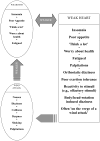Olfactory-triggered panic attacks among Khmer refugees: a contextual approach
- PMID: 15446720
- PMCID: PMC2791797
- DOI: 10.1177/1363461504043564
Olfactory-triggered panic attacks among Khmer refugees: a contextual approach
Abstract
One hundred Khmer refugees attending a psychiatric clinic were surveyed to determine the prevalence of olfactory-triggered panic attacks as well as certain characteristics of the episodes, including trigger (i.e. type of odor), frequency, length, somatic symptoms, and the rate of associated flashbacks and catastrophic cognitions. Forty-five of the 100 patients had experienced an olfactory-triggered panic attack in the last month. Trauma associations and catastrophic cognitions (e.g. fears of a 'wind attack', 'weakness', and 'weak heart') were common during events of olfactory panic. Several case examples are presented. A multifactorial model of the generation of olfactory panic is adduced. The therapeutic implications of this model for the treatment of olfactory panic are discussed.
Figures
References
-
- American Psychiatric Association. Diagnostic and statistical manual of mental disorders. 4. Washington, DC: American Psychiatric Association; 1994.
-
- Barlow D, Craske M. Mastery of your anxiety and panic. 2. Albany, NY: Graywind; 1994.
-
- Barsky AJ, Borus JF. Functional somatic syndromes. Annals of Internal Medicine. 1999;130:910–921. - PubMed
-
- Binkley KE, Kutcher S. Panic response to sodium lactate infusion in patients with multiple chemical sensitivity syndrome. Journal of Allergy and Clinical Immunology. 1997;99:570–574. - PubMed
-
- Bouton M, Mineka S, Barlow D. A modern learning theory perspective on the etiology of panic disorder. Psychological Review. 2001;108:4–32. - PubMed
Publication types
MeSH terms
Grants and funding
LinkOut - more resources
Full Text Sources
Medical





